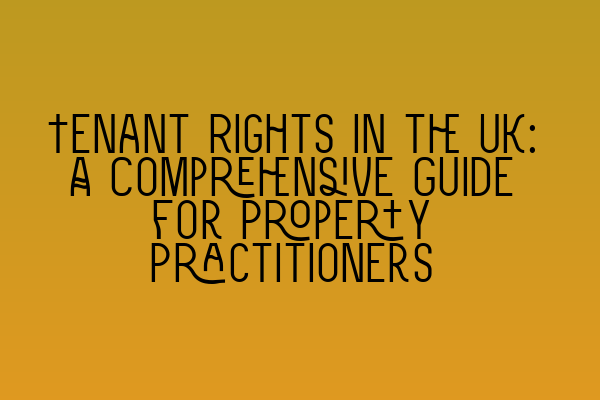Tenant Rights in the UK: A Comprehensive Guide for Property Practitioners
As property practitioners, it is crucial to have a comprehensive understanding of tenant rights in the UK. Knowing the legal rights and obligations for both landlords and tenants will not only help ensure compliance with the law but also promote fair and smooth transactions in the rental market. In this guide, we will delve into the various aspects of tenant rights, providing you with the knowledge and insights you need to navigate this complex area of property law.
Before we proceed, if you are preparing for the SQE exams, make sure to check out our related articles on SQE 1 Practice Exam Questions, SQE 1 Practice Mocks FLK1 FLK2, SQE 2 Preparation Courses, SQE 1 Preparation Courses, and SRA SQE Exam Dates.
1. Understanding the Tenancy Agreement
The first step in understanding tenant rights is to familiarize yourself with the legal document that forms the foundation of the landlord-tenant relationship – the tenancy agreement. This contract outlines the rights and responsibilities of both parties and sets out the terms and conditions of the tenancy. It is essential to review and understand the agreement thoroughly before entering into any rental arrangement.
2. Types of Tenancies in the UK
In the UK, various types of tenancies exist, each offering different rights and protections to tenants. These include:
– Assured Shorthold Tenancy (AST): This is the most common type of tenancy in the UK and offers tenants a minimum of six months’ security of tenure.
– Rent Act Tenancy: This type of tenancy is governed by the Rent Act 1977 and is prevalent among older tenancies created before 1989.
– Common Law Tenancy: Common law tenancies are less regulated than other forms of tenancies and require a thorough understanding of case law and legal principles for proper handling.
– Holiday Lettings: These are short-term rentals typically used for vacation purposes and are subject to different regulations compared to long-term tenancies.
By familiarizing yourself with the different types of tenancies, you can better advise your clients and ensure that their rights are protected under the appropriate legal framework.
3. Tenant Rights and Responsibilities
As a property practitioner, it is essential to provide accurate information to your clients regarding their rights and responsibilities as tenants. Key rights and responsibilities include:
– Right to quiet enjoyment: Tenants have the right to peacefully and quietly enjoy their rented property without unnecessary interference from the landlord.
– Right to a safe and habitable property: Landlords have a legal obligation to ensure that the rented property meets certain health and safety standards.
– Right to repairs: If the property is in disrepair, tenants have the right to request necessary repairs from the landlord.
– Responsibility for paying rent: Tenants are responsible for paying rent in a timely manner and should be aware of their obligations in this regard.
By educating your clients about these rights and responsibilities, you can help prevent potential disputes and promote a positive and mutually beneficial landlord-tenant relationship.
4. Evictions and Tenant Protections
In certain circumstances, landlords may seek to evict their tenants. However, this process must adhere to strict legal requirements and procedures. It is vital to understand the eviction process in order to advise your clients accordingly and ensure that their rights are protected throughout.
The UK has introduced several measures to protect tenants from unfair evictions, such as the Tenant Fees Act 2019 and the Coronavirus Act 2020. These acts aim to provide tenants with greater security and protection against eviction, particularly during the ongoing COVID-19 pandemic.
5. Additional Tenant Protections
In addition to the rights and protections mentioned above, tenants in the UK are also safeguarded by various other laws and regulations, including:
– Deposit Protection: Landlords are required to protect their tenants’ deposits in a government-approved deposit protection scheme.
– Anti-Discrimination Laws: It is illegal for landlords to discriminate against tenants based on protected characteristics such as race, age, religion, disability, or gender.
– Tenancy Deposit Schemes: Landlords must comply with tenancy deposit schemes and return the deposit to the tenant at the end of the tenancy, subject to any deductions for damages or unpaid rent.
By understanding these additional tenant protections, you can ensure that your clients are fully informed about their legal rights and can take appropriate action if necessary.
In conclusion, as property practitioners dealing with tenant-related matters, it is crucial to have a comprehensive understanding of tenant rights in the UK. By familiarizing yourself with the different types of tenancies, rights and responsibilities, eviction procedures, and tenant protections, you can effectively advise your clients and promote fair and lawful practices in the rental market.
If you found this guide helpful, make sure to check out our related articles on SQE 1 Practice Exam Questions, SQE 1 Practice Mocks FLK1 FLK2, SQE 2 Preparation Courses, SQE 1 Preparation Courses, and SRA SQE Exam Dates for further preparation for your SQE exams.
At SQE Property Law & Land Law, we are here to assist you with all your property law needs. Contact us today to learn how we can help you navigate the intricacies of tenant rights and ensure compliance with UK property law.
